ZHCS094A September 2008 – November 2014 PCM3070
PRODUCTION DATA.
- 1 特性
- 2 应用
- 3 说明
- 4 LP38690 的
- 5 修订历史记录
- 6 Device Comparison Table
- 7 Pin Configuration and Functions
-
8 Specifications
- 8.1 Absolute Maximum Ratings
- 8.2 Handling Ratings
- 8.3 Recommended Operating Conditions
- 8.4 Thermal Information
- 8.5 Electrical Characteristics, ADC
- 8.6 Electrical Characteristics, Bypass Outputs
- 8.7 Electrical Characteristics, Audio DAC Outputs
- 8.8 Electrical Characteristics, LDO
- 8.9 Electrical Characteristics, Misc.
- 8.10 Electrical Characteristics, Logic Levels
- 8.11 I2S LJF and RJF Timing in Master Mode (see )
- 8.12 I2S LJF and RJF Timing in Slave Mode (see )
- 8.13 DSP Timing in Master Mode (see )
- 8.14 DSP Timing in Slave Mode (see )
- 8.15 I2C Interface Timing
- 8.16 SPI Interface Timing (See )
- 8.17 Typical Characteristics
- 9 Parameter Measurement Information
- 10Detailed Description
- 11Application and Implementation
- 12Power Supply Recommendations
- 13Layout
- 14器件和文档支持
- 15机械封装和可订购信息
1 特性
2 应用
- 条形音箱
- 平板电视
- MP3 坞站
- 蜂窝电话坞站
- 其他立体声或 2.1 家用音频系统
3 说明
PCM3070 是一款灵活的立体声音频编解码器,配有可编程输入和输出、完全可编程 miniDSP、固定式预定义和可参数化信号处理块、集成式 PLL、集成式 LDO 以及灵活的数字接口。
器件信息(1)
| 器件型号 | 封装 | 封装尺寸(标称值) |
|---|---|---|
| PCM3070 | 超薄四方扁平无引线 (VQFN) (32) | 5.00mm x 5.00mm |
- 要了解所有可用封装,请见数据表末尾的可订购产品附录。
4 LP38690 的
